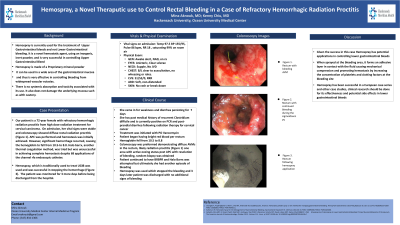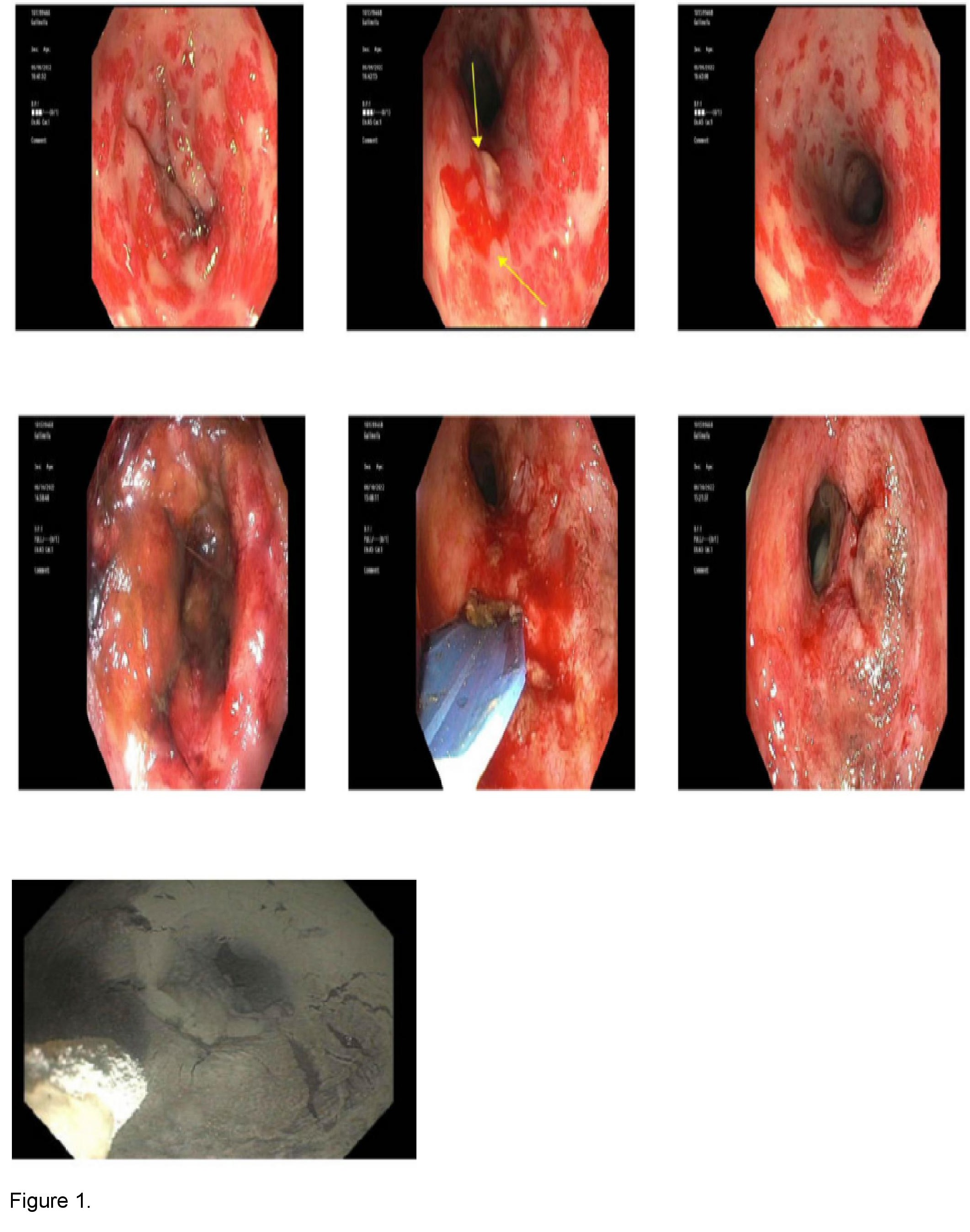Back


Poster Session C - Monday Afternoon
Category: GI Bleeding
C0343 - Hemospray, a Novel Theraputic Use to Control Rectal Bleeding in a Case of Refractory Hemorrhagic Radiation Proctitis
Monday, October 24, 2022
3:00 PM – 5:00 PM ET
Location: Crown Ballroom

Has Audio
.jpg)
Mina Aknouk, MD
Ocean University Medical Center
Brick, NJ
Presenting Author(s)
Mina Aknouk, MD1, Kenny Chiu, MD2
1Ocean University Medical Center, Brick, NJ; 2Coastal Gastroenterology, Brick, NJ
Introduction: One long term complication of pelvic radiation therapy is hemorrhagic radiation proctitis. Argon Plasma Coagulation (APC) is the most frequently used thermal coagulation method to control hemorrhage from the rectum’s telangiectasias. APC’s downsides include difficulty in controlling the position of the coagulation and the depth of the burn may be variable. Other current therapies to control bleeding are Formalin application, cryoablation, and radiofrequency ablation. Hemospray is a novel agent to control large area gastric bleeds or bleeding from malignancies, showing promising results in a small case series in Europe.
Case Description/Methods: Our patient is a 72-year female with refractory hemorrhagic radiation proctitis from high dose radiation treatment for cervical carcinoma. On admission, her vitals were stable and colonoscopy showed diffuse rectal radiation proctitis (Figure 1). APC was performed and hemostasis was initially achieved. However, significant hemorrhage recurred, causing the hemoglobin to fall from 10.5-to 8.8. Halo barrx, another thermal coagulation method, was tried but was unsuccessful in achieving complete hemostasis despite 68 applications of the channel rfa endoscopic catheter. Hemospray, which is traditionally used to treat UGIB was used and was successful in stopping the hemorrhage (Figure 1). The patient was monitored for 3 more days before being discharged from the hospital.
Discussion: Hemospray is generally used for UGI (gastric) and not Lower Gastrointestinal bleeding. It is a novel hemostatic agent, using an inorganic, inert powder, and is very successful in controlling Upper Gastrointestinal Bleed (UGIB). When sprayed at the bleeding area, it forms an adhesive layer in contact with the fluid causing mechanical compression and promoting hemostasis by increasing the concentration of platelets and clotting factors at the bleeding site. It can be used in a wide area of the gastrointestinal mucosa and thus is very effective in controlling bleeding from widespread vascular ectasias. There is no systemic absorption and toxicity associated with its use. It also does not damage the underlying mucosa with cautery. Studies have been done to evaluate its use in UGIB but not so in LGIB. A small case series done in Europe showed that using Hemospray is also feasible in LGIB. Considering the success in our case, we recommend further exploring the use of Hemospray for the treatment of persistent radiation proctitis and possibly other causes of LGIB.

Disclosures:
Mina Aknouk, MD1, Kenny Chiu, MD2. C0343 - Hemospray, a Novel Theraputic Use to Control Rectal Bleeding in a Case of Refractory Hemorrhagic Radiation Proctitis, ACG 2022 Annual Scientific Meeting Abstracts. Charlotte, NC: American College of Gastroenterology.
1Ocean University Medical Center, Brick, NJ; 2Coastal Gastroenterology, Brick, NJ
Introduction: One long term complication of pelvic radiation therapy is hemorrhagic radiation proctitis. Argon Plasma Coagulation (APC) is the most frequently used thermal coagulation method to control hemorrhage from the rectum’s telangiectasias. APC’s downsides include difficulty in controlling the position of the coagulation and the depth of the burn may be variable. Other current therapies to control bleeding are Formalin application, cryoablation, and radiofrequency ablation. Hemospray is a novel agent to control large area gastric bleeds or bleeding from malignancies, showing promising results in a small case series in Europe.
Case Description/Methods: Our patient is a 72-year female with refractory hemorrhagic radiation proctitis from high dose radiation treatment for cervical carcinoma. On admission, her vitals were stable and colonoscopy showed diffuse rectal radiation proctitis (Figure 1). APC was performed and hemostasis was initially achieved. However, significant hemorrhage recurred, causing the hemoglobin to fall from 10.5-to 8.8. Halo barrx, another thermal coagulation method, was tried but was unsuccessful in achieving complete hemostasis despite 68 applications of the channel rfa endoscopic catheter. Hemospray, which is traditionally used to treat UGIB was used and was successful in stopping the hemorrhage (Figure 1). The patient was monitored for 3 more days before being discharged from the hospital.
Discussion: Hemospray is generally used for UGI (gastric) and not Lower Gastrointestinal bleeding. It is a novel hemostatic agent, using an inorganic, inert powder, and is very successful in controlling Upper Gastrointestinal Bleed (UGIB). When sprayed at the bleeding area, it forms an adhesive layer in contact with the fluid causing mechanical compression and promoting hemostasis by increasing the concentration of platelets and clotting factors at the bleeding site. It can be used in a wide area of the gastrointestinal mucosa and thus is very effective in controlling bleeding from widespread vascular ectasias. There is no systemic absorption and toxicity associated with its use. It also does not damage the underlying mucosa with cautery. Studies have been done to evaluate its use in UGIB but not so in LGIB. A small case series done in Europe showed that using Hemospray is also feasible in LGIB. Considering the success in our case, we recommend further exploring the use of Hemospray for the treatment of persistent radiation proctitis and possibly other causes of LGIB.

Figure: Figure 1. Top row demonstrates Images in the rectum from the first colonoscopy identifying the bleeding AVM from the radiation proctitis. Second row shows images from the follow up flexible sigmoidoscopy with continued. Bottom row final image shows the results of the hemospray controlling the cessation of bleeding.
Disclosures:
Mina Aknouk indicated no relevant financial relationships.
Kenny Chiu indicated no relevant financial relationships.
Mina Aknouk, MD1, Kenny Chiu, MD2. C0343 - Hemospray, a Novel Theraputic Use to Control Rectal Bleeding in a Case of Refractory Hemorrhagic Radiation Proctitis, ACG 2022 Annual Scientific Meeting Abstracts. Charlotte, NC: American College of Gastroenterology.
